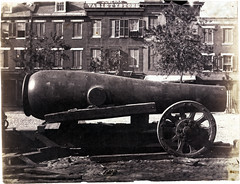The New York Times, September 3, 1860
Correspondence
Old Point Comfort, (Va.) Wednesday, Aug. 29.
The curiosity of the Artillery officers, and of the guests at Old Point was gratified yesterday by the first firing of the great “Floyd” Gun of which I have before spoken. The first shell weighing 360 pounds was thrown fifteen hundred and forty yards at an angle of five degrees and striking the sand, bounced seven hundred and fifty yards further. The charge of powder was twenty pounds. The second shell weighing 328 pounds was thrown something upwards of four miles on the water, at an angle of forty degrees and with a charge of twenty-five pounds of powder. The powder with which this gun is fired is in grains of about one inch cube. The report is not so loud as that made by the ten inch guns on the ramparts, but the whistling of the shell through the air is terrific. The shell thrown upon the water was forty-two seconds in the air before striking. The “Floyd” Gun is pronounced a success and there seems to be no doubt it will reach a range of six or eight miles. It weighs 49,099 lbs—and cost in its casting $10,000. Both the projector (Capt. RODMAN), and the proprietor of the Pittsburg foundry (Mr. KNAPP) where the cannon was cast, are here superintending the firing of this monster Gun. The experiments are conducted by Capt. DYER of the Ordnance Department—one of the most experienced and scientific officers belonging to the army—and quite as an accomplished gentleman as he is an able officer.
Lieut. BOGGS, a promising young officer, is preparing to test the “Floyd” shells by means of an ingenious telegraphic arrangement. As the shell passes from the mouth of the cannon it cuts a wire, which produces a current and sets in motion a pendulum at an instrument securely arranged under the casemate of the fort. The target, placed at a fixed distance, is covered with a series of wires, one of which must be cut by the shell when it strikes the target. The moment the second wire is cut the current is broken, and the pendulum instantly stops, marking the space through which it had passed during the time the shell was passing between the two wires.
